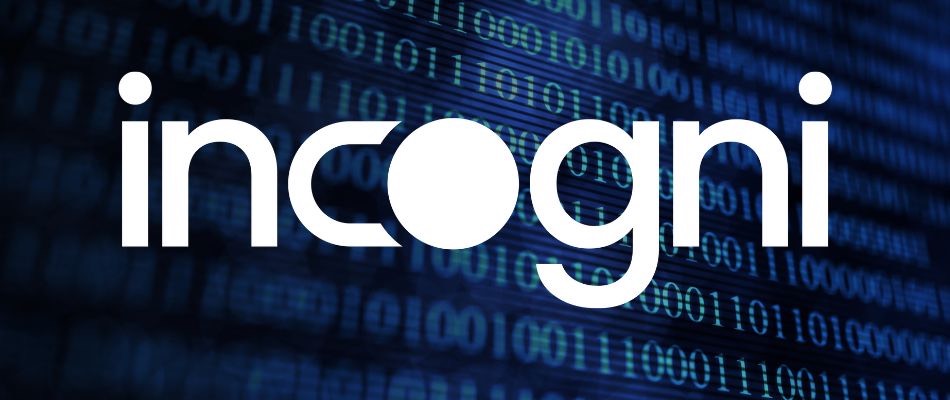
In a world where personal privacy is under constant siege by data brokers and online trackers, protecting your digital footprint has never been more important. These irritating individuals and companies, armed with your personal information, construct intricate profiles that delve deep into your life, from your financial records to your medical history, without your consent. But fear not, for there’s a powerful player in the privacy game, and its name is Incogni.
In our Incogni review, we’ll shine a light on its data removal service that stands as a formidable shield against the invasive practices of information brokers. However, while with Incogni you have the power to erase your presence from these data broker sites, you won’t get in-depth data removal reports as proof.
Still, Incogni offers an extensive personal data removal service with a simple-to-use dashboard, pocket-friendly plans, and strong security measures. Also, it has added a new type of data broker into its arsenal to make sure your private information stays private.
It’s time to look at the key points of our hands-on Incogni review.
Key points for using Incogni
- Incogni offers a comprehensive data removal service with an easy-to-use dashboard, budget-friendly plans, and solid security measures.
- It is associated with Surfshark and has attractive features such as opt-outs and adherence to information privacy laws.
- Incogni provides users with rock-solid protection for their online presence in 2024 at a reasonable price point.
Incogni Cyber Deal is live:
Get 50% off Incogni with the exclusive coupon link below:
(Coupon is applied automatically; 30 day money-back guarantee.)
Now, let’s take a look at the pros and cons of choosing Incogni to protect your digital privacy.
Pros
- 30-day money-back guarantee for all subscribers
- Covers around 200 data brokers
- Easy-to-understand interface
- Fairly fast response and removals
- Updates on the data removal process each week
- Relatively reasonable pricing
- Repeats removal requests when needed
- Super simple sign-up process
Cons
- No in-depth reports of personal information
- No free trial or free edition
Incogni feature summary
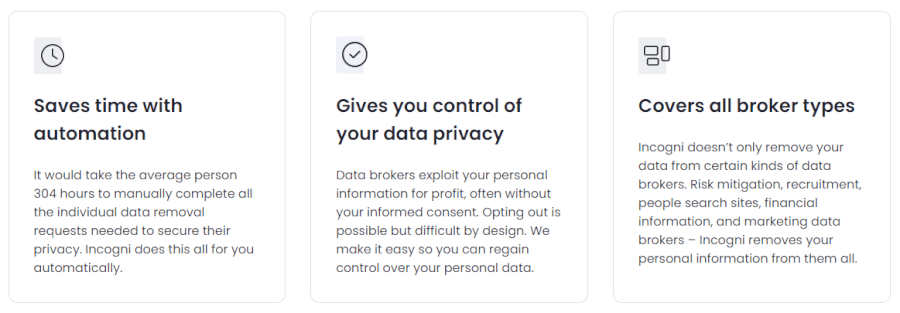
Incogni provides an impressive set of features designed to help you regain control of your personal data. Some of its standout features include:
- Sophisticated dashboard: Incogni offers a user-friendly dashboard that allows you to easily manage your data removal requests, track their progress, and view broker ratings.
- Automated data removal: Incogni’s internal algorithm predicts which information brokers may have your information and automatically sends removal requests to them.
- Privacy regulation compliance: Incogni leverages privacy regulations such as CCPA, GDPR, and PIPEDA to enforce the deletion of your data from data brokers’ databases. This compliance covers residents of the US, the UK, Canada, Switzerland, and the EU.
- Transparent pricing: Incogni offers an attractive pricing model, with options at $6.49 per month for a one-year plan or $13.39 per month. It a cost-effective solution for cyber privacy enthusiasts.
- Ongoing data removal efforts: It doesn’t stop at just one attempt. After Incogni contacts data brokers, it continues to send data removal requests to them. This ensures the consistent removal of your sensitive data from the web.
- Super simple sign-up: Incogni boasts an incredibly user-friendly and straightforward sign-up process. You can start in just a few minutes, making it accessible for users of all tech levels.
- 30-day money-back guarantee: If you find that Incogni doesn’t meet your expectations within the first month of usage, you can request a full refund with no questions asked.
See all Incogni features here >>
While Incogni boasts many advantages, such as its affordability and user-friendly interface, it’s important to note that it has its fair share of limitations. However, we’ll deal with these drawbacks a bit later.
Meanwhile, embark on a journey to reclaim control over your online persona through our meticulously chosen list of best data removal services. These effective solutions are tailored to enhance data privacy and streamline the removal of your digital traces.
Company history, success rate, and reputation: Can we trust Incogni?

While the in-depth history of Incogni isn’t readily available, it’s important to note that the company is backed by Surfshark, a well-known VPN provider. This partnership adds a layer of credibility to Incogni’s reputation as a reliable data removal tool.
Headquartered in Amsterdam (the Netherlands), Incogni boasts a team of up to 200 employees dedicated to enhancing online privacy and security. With a rock-solid track record, Incogni seems like a trustworthy option for those seeking to strengthen their cyber privacy against crafty data collectors.
Incogni’s connection with Surfshark VPN further reinforces its commitment to enhancing online privacy and security.
If you’re thinking about boosting your online security and privacy with one of the top VPN solutions, you should also check out our ExpressVPN review and NordVPN review as they’re the cream of the crop.
Privacy laws and regulations that empower Incogni
Incogni relies on the data removal rights granted by the California Consumer Privacy Act (CCPA), the General Data Protection Regulation (GDPR), and other privacy regulations such as Canada’s Personal Information Protection and Electronic Documents Act (PIPEDA) to compel data brokers to, well, remove your personal information from their databases. By utilizing these privacy laws, Incogni delivers an effective solution for those aiming to eradicate their personal data from the internet.
While these laws and regulations cover specific areas of the world, to avoid complications, information brokers often comply with them even if the person whose private data they are deleting doesn’t live in one of these areas. Right now, Incogni serves residents of the United States, the UK, Canada, Switzerland, and the EU.
We should also note that while laws and regulations allow you to remove your data from online databases, these cunning companies often make this process slow and complicated to hold back your information and profits.
Strengthening your online privacy is paramount in today’s digital age. Learn practical steps on how to not get doxxed – when personal information is publicly revealed online, often with malicious intent – in our insightful guide.
Incogni data removal capabilities: How does Incogni remove your personal information from the internet?

Incogni swiftly erases your personal data online by sending removal requests to over 180 data brokers. They kick-start this process upon sign-up, with most data brokers responding within a week. In case of delays, Incogni resends removal requests and keeps you in the loop with weekly progress updates. This ensures a transparent and trustworthy data removal process.
Data broker opt-outs: How does Incogni battle data brokers for you?
Incogni takes on new data brokers by using its algorithm to predict which ones may have your data and then automatically sends removal requests. This ensures that your data remains off the market without you having to do the heavy lifting. The platform manages all communication with data collectors, allowing you to track the progress of all your data broker opt-out requests using the Incogni dashboard.
Incogni brings several superb benefits to the table. It streamlines the data removal process, providing a convenient and highly effective solution for protecting your online personal information. Additionally, it automates the removal of your data while consistently monitoring data brokers. With an active Incogni subscription, you can trust that Incogni consistently deletes your digital footprint from various data brokers.
Deleting yourself from the internet manually is possible, but for a more effective and comprehensive solution, turning to a data removal service is the way to go.
The first steps: Setting up and using Incogni
With Incogni, you only provide the minimum information needed to search for your records with data broker companies. Initially, you’ll need to share your:
- Email address
- Full name
- Home address
- City of residence
- Country of residence
- State/Province
- Zip code
For more extensive coverage, Incogni might request your phone number (with country code) and date of birth. Although it may seem like a lot, it’s the minimum needed for the service to work effectively, and it’s a lot less intrusive than what some data brokers demand, like copies of your ID and photos of you holding documents.
To start, go to Incogni.com and click the Sign up button. You’ll see the Create an account screen.
Start your sign-up process
Enter your Email address and Password. It is important to enter the email address you usually use to register for services here, as that increases the chance data brokers will be able to find and eliminate your personal data.
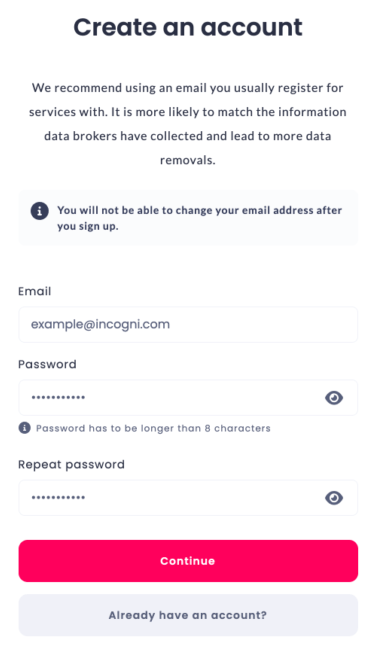
Click Continue to open the Personal Information screen.
Personal information screen
Now, you’ll provide Incogni with some personal information so it can search for your data in data broker systems.
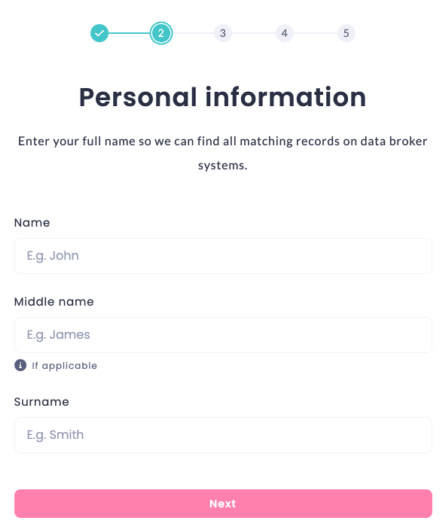
You should fill out all the information on this Personal information screen, as well as on the Address information screen that follows.
Next, you will see the Authorization form screen. This replaces the Power of Attorney screen that Incogni used previously.
Authorization form screen
You need to complete this Authorization form before Incogni can contact data brokers. This document confirms to the data brokers that they are receiving official data removal requests, not some random vandalism by someone who happens to know your personal data.
Please note that this authorization has limitations. It only grants Incogni the specific rights outlined in the document. It restricts Incogni to exercising your right to request the removal of your data under relevant privacy laws. You aren’t giving Incogni unlimited power over your life or anything like that.
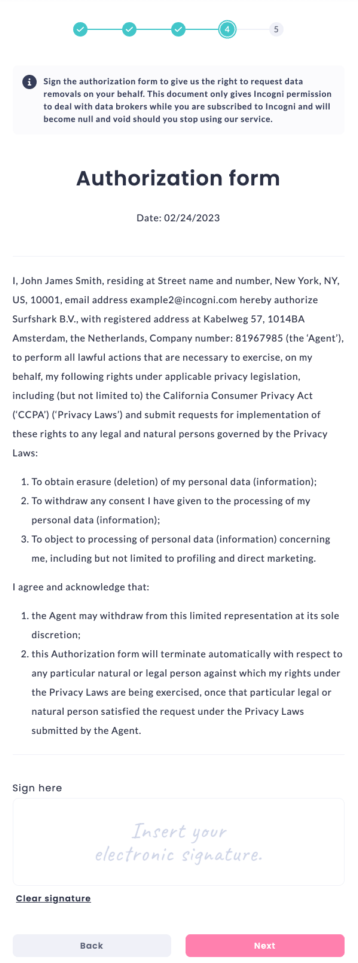
Sign the document using your mouse or whatever pointing device works for you. Then click Next to see the Checkout screen.
Checkout screen
Now that you are all set up, it is time to pay up. You can choose between the monthly plan and the one-year option, and pay using PayPal or a credit or debit card.
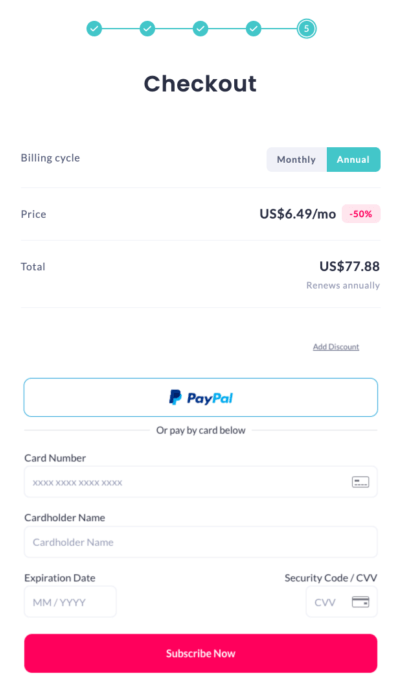
Once you’ve completed these steps, your account will become active, and you can access your Incogni dashboard.
Features and benefits: What do you get with Incogni?
In this chapter, we’re diving deep into Incogni’s features and benefits, unveiling the powerful tools it offers to help you regain control of your personal data.
Easy-to-use dashboard
The dashboard tab makes it easy to see what is happening with your official removal requests. As you can see in the image below, The top section of the Dashboard shows the number of removal Requests sent, the Requests in progress, and the Requests completed.
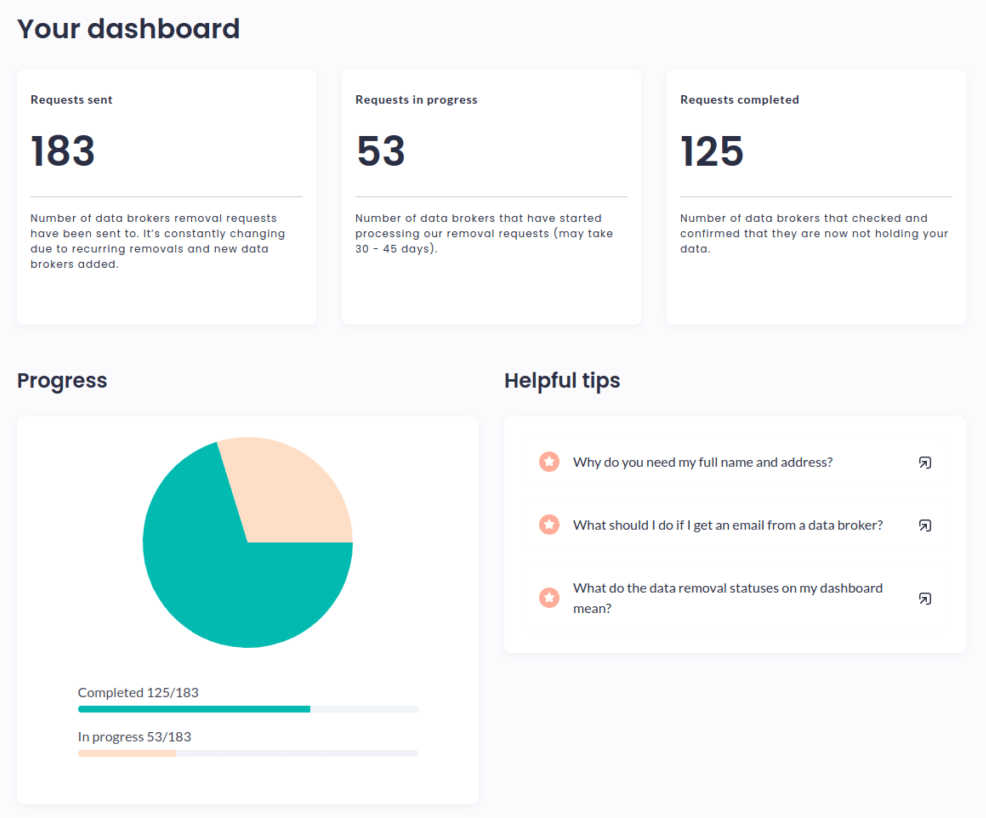
The preceding image shows the results that Incogni has achieved over the months since our last review of the service. You can see that Incogni has sent 183 requests to data brokers, with 53 of them currently in progress and 125 already completed.
This kind of result is not unusual. Brokers don’t always respond quickly to data removal requests, and apparently, some brokers simply ignore them altogether. Still, having Incogni remove my data from more than half of the brokers it contacted helps protect my privacy.
The bottom section of the Dashboard has a pie chart of your removal request progress, along with some helpful tips.
The Dashboard gives you a big-picture view of Incogni’s progress and is pretty self-explanatory. But if you want to dig deeper, you can select the Detailed view tab.
If you’re looking for simplicity, DeleteMe also boasts an incredibly user-friendly dashboard. Dive into our comprehensive guide on Incogni vs DeleteMe for a detailed comparison between these services.
Scanning public and private databases
The Detailed view tab now offers more information than before. Additionally, it not only lists the specific data brokers Incogni has contacted on your behalf but can also separately scan private databases as well as public databases for your information. However, it’s worth noting that scanning public databases can take a significant amount of time, so you should be prepared to wait a while.
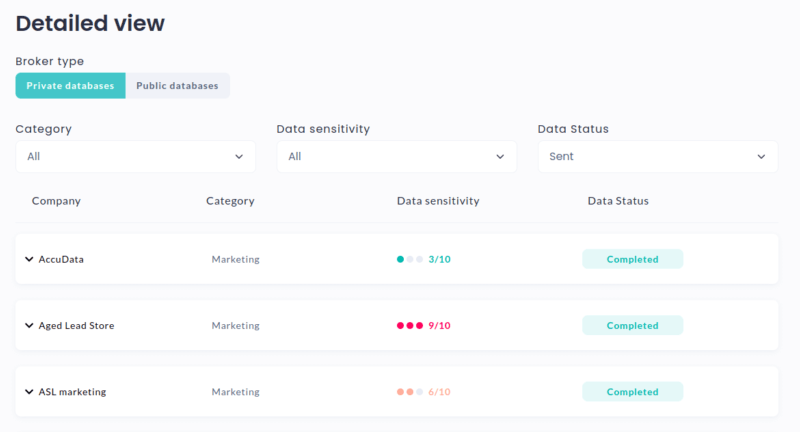
The Detailed view tab shows a list of every broker it contacted, along with their individual status. You can use the Category, Data Sensitivity, and Data Status lists to filter the list of brokers in various ways. Clicking the down arrow to the left of the name of a broker displays detailed information about that broker.
A detailed look at a specific broker
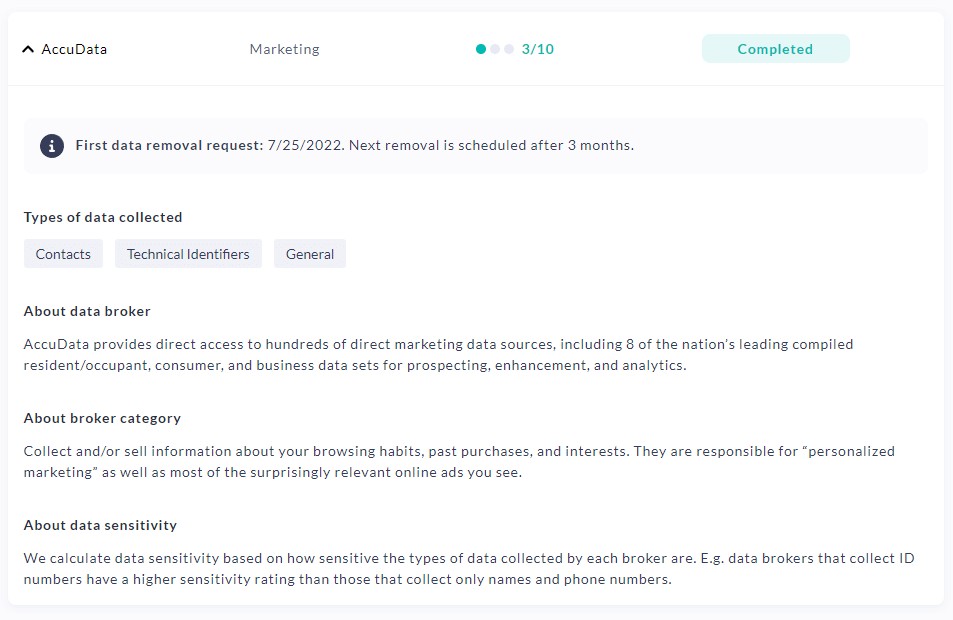
If you’re eager to dive into the nitty-gritty details of each data broker that Incogni contacted on your behalf, this is where you’ll find it. In a comprehensive report, you’ll find:
- Data broker names
- Their respective categories
- Data sensitivity scores (ranging from 1 to 10)
- Data removal status
- Removal request timelines
- Types of data collected
- Broker information
- Category insights
- Details on how Incogni calculates data sensitivity, ensuring you have a complete picture of your privacy protection.
Privacy Bee is an outstanding choice if you desire a remarkable service with simple-to-understand reports. For a comprehensive look at how it stacks up against Incogni, consult our Incogni vs Privacy Bee guide.
A new category for Incogni – People Search Sites
People Search Sites appear within Incogni under the Public databases section of the Detailed view. They are those websites where anyone can go to get all sorts of information about almost any person.
Here’s an example of the preliminary search results for a man named Donald Trump, from New York City:
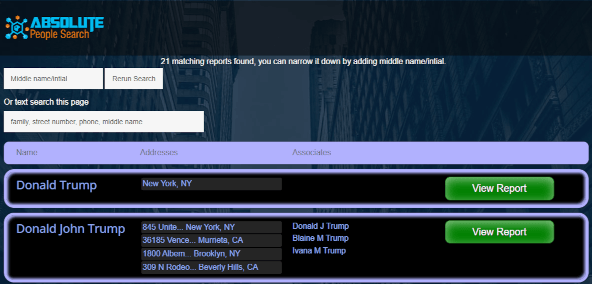
By clicking one of the View Report buttons, you can access a detailed report containing comprehensive information about the person, including their full contact details, social media profiles, photos, criminal records, personal financial information, and more.
The person revealed in the report will likely never know, but someone has just acquired a huge amount of information about them.
As with other types of data brokerage services, Incogni will contact the major People Search Sites on your behalf and demand that information about you be deleted from their database.
If you want to protect your digital privacy even better, consider utilizing one of the most secure web browsers that’ll keep your data safe from third parties.
Meanwhile, if you find yourself overwhelmed by a deluge of junk email and spam, our guide on how to massively reduce junk email and spam provides savvy strategies to tidy up your inbox.
The drawbacks of using Incogni
While Incogni offers user-friendly data removal services, it does have some serious limitations.
Removing your information from People Search Sites feels like a chore
I recently asked Incogni to clear my information out of People Search Sites. It took the Incogni site a few minutes to initiate the process. Then I received a slightly confusing email. It said:
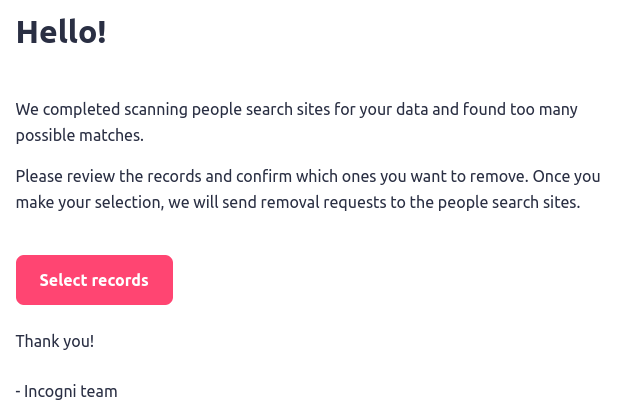
Once I concluded that the email was not a scam, I clicked the Select records button. This took me to the Incogni website, where I was presented with 32 screens like this one:
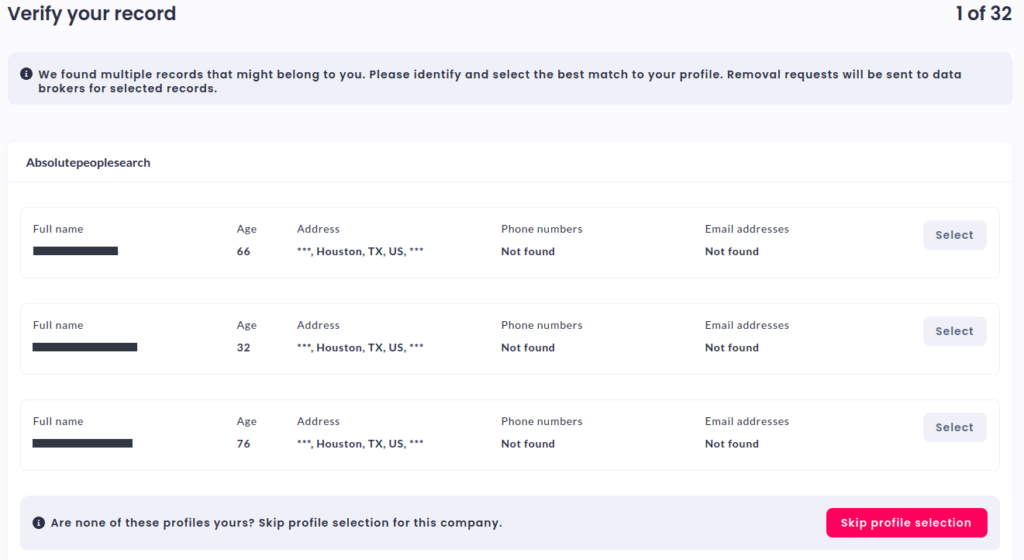
I needed to select the records that actually pertained to me. In the cases where none of the records pertained to me, clicking the Skip profile selection button took me to the next screen. Once this annoying chore was complete, a box popped up telling me that removal requests had been sent to all records matching my profile.
Incogni doesn’t deal with all the data brokers
While Incogni works with around 200 data brokers, they don’t cover the entirety of the ever-expanding data brokerage landscape, which spans from a few hundred to potentially a few thousand. New data brokers constantly emerge to tap into user data. Achieving full coverage is improbable, but having your data removed from a number of data brokers is an important improvement for your privacy.
Incogni doesn’t know which brokers have your data
Incogni faces a unique challenge when it comes to identifying which data brokers possess your information. Unlike sending blanket data removal requests to all companies for all users, Incogni employs an internal algorithm to pinpoint databases that are likely to store your data, sending removal requests selectively.
While the specifics of this algorithm remain a mystery, we trust that it optimizes the process, minimizing the risk of overlooking potential data brokers holding your information.
Incogni doesn’t know if a broker has actually removed your data
Incogni’s approach to data removal involves an indirect process. They lack direct access to data broker databases, making it impossible for them to confirm data removal firsthand. They instead rely on the fact that there are legal penalties for not removing someone’s data after it has been requested.
You can only enter one email address (for now)
At the time of this Incogni review, Incogni only supports a single email address for each of their users. While their FAQ mentions plans to introduce support for multiple email addresses, no specific release date has been provided at this time.
Incogni’s Security and Privacy Measures: Is Incogni safe to use?
In an era marked by a surge in cyberattacks, strong cybersecurity practices have become paramount to safeguarding your digital presence and personal information.
Thankfully, Incogni takes data security seriously. They use robust encryption to keep your information safe while minimizing the data they collect. This not only ensures your privacy but also helps them comply with privacy regulations.
It’s important to note that Incogni doesn’t offer many extra security features beyond these essentials. However, their commitment to data protection and minimal data collection means you can trust them to handle your data securely while removing it from the internet.
If you’re looking for a way to restore your digital privacy, check out some of the best privacy tools available today. In the meantime, if you’re fed up with the constant irritation of robocalls, delve into our comprehensive guide on putting an end to spam calls and robocalls.
Incogni’s privacy policy
Incogni prioritizes your privacy with a clear and trustworthy privacy policy. Here are the key highlights:
- Transparency: Incogni shares customer data only with trusted service partners.
- Data removal: Your data is deleted within 12 months after you stop using the service or upon request.
- Legal compliance: The company complies with legal requests.
With transparent data handling practices and robust security measures, you can trust Incogni to protect your personal information as you navigate the world of online privacy.
To be sure, you can check Incogni’s privacy policy for yourself.
Fed up with your personal details being out there on Whitepages? Our guide on how to opt out of Whitepages gives you step-by-step instructions to take back control and remove your data from their database.
Pricing and subscription plans: Choosing the right option

Incogni Cyber Deal is live:
Get 50% off Incogni with the exclusive coupon link below:
(Coupon is applied automatically; 30 day money-back guarantee.)
Incogni offers two subscription plans, billed either annually or monthly. The annual plan, priced at $6.49 per month, is the more cost-effective option, while the monthly subscription costs $13.39 per month. If you go with the monthly plan, you can of course cancel after one month and save yourself a lot of money. However, it may still be worthwhile to go with the annual plan.
The annual plan not only saves users money, but also ensures continuous monitoring and data removal from data brokers’ databases. Also, Incogni frequently adds new data brokers to the list of brokers they deal with. If you are subscribed when they do, they will automatically send an official removal request for you.
Incogni now offers a family-friendly plan, like we found in our DeleteMe review.
While there’s no free Incogni subscription or a free trial, both its plans are backed by a 30-day money-back guarantee, ensuring that users can confidently try out the service risk-free. We also found Incogni to offer the best value in our Optery vs Incogni comparison.
If you want to find out more about the refund policy, you can check out Incogni’s website here for yourself.
Customer support and resources: What sort of help do you get with Incogni?
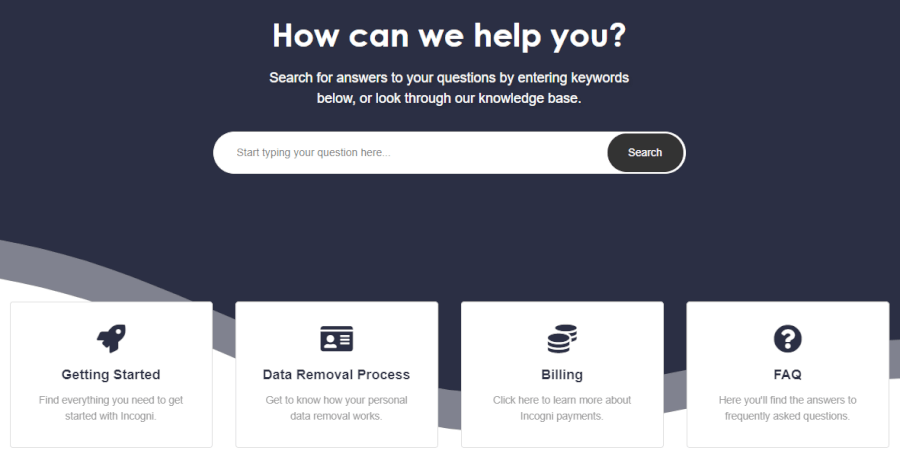
Incogni provides email support and a well-stocked knowledgebase covering topics such as the data removal process and dealing with data brokers. If you want to reach out to Incogni’s customer support staff, you can do it via email, and that’s about it.
However, despite the absence of live chat, Incogni’s email support and knowledgebase do a decent job of ensuring that users have access to the needed information and assistance.
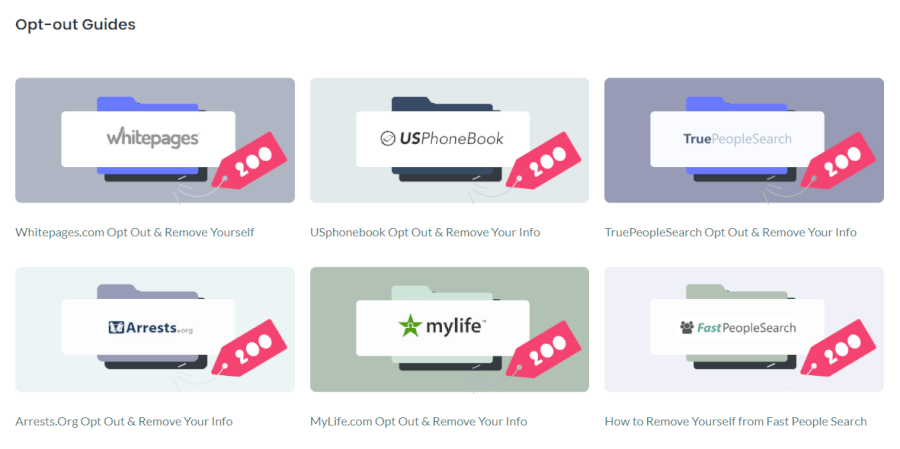
Incogni goes the extra mile to empower users with simple and effective opt-out guides. These guides are available on their official blog, making it easy for anyone to understand and follow the steps to safeguard their digital privacy.
Competition: What are the best alternatives to Incogni?
As the world of online privacy protection continues to evolve, it’s essential to explore other effective data removal solutions and their privacy safeguards.
Incogni is more budget-friendly than DeleteMe which makes it more attractive to users on a tight budget. Meanwhile, DeleteMe’s broader data broker coverage makes it an appealing option for those seeking a more comprehensive solution.
Incogni offers a simpler user interface than Privacy Bee which makes it a super choice for first-time users. However, Privacy Bee offers additional features like tracker blocking and real-time threat monitoring which appeals to more experienced users.
Unlike most similar services, Incogni included, Optery offers a cost-free edition with limited features. While both services come with a 30-day, no-questions-asked, money-back guarantee, Optery is a more pocket-friendly choice with a family-friendly option to boot.
If you want to take a look at our in-depth reviews of Incogni’s competitors, check out our DeleteMe review, Privacy Bee review, and Optery review.
Incogni FAQ
Is Incogni legit?
Yes, we are confident that Incogni is legit. This service was built by Surfshark, the same people who brought us the widely respected Surfshark VPN.
What does Incogni do?
Incogni acts on your behalf to compel data brokers to remove your data from their databases. They contact them with official data removal requests and rely on the CCPA and GDPR data-protection regulations to compel the data brokers to comply.
Where is Incogni available?
At the time of this Incogni review, the service is only available for residents of the US, UK, Canada, Switzerland, and EU.
Why does Incogni need an Authorization form?
Since Incogni is going to send data removal requests on your behalf, the information resellers need some way to know that the requests are legitimate. The Authorization form proves that Incogni is authorized to request data removal on your behalf.
Incogni review conclusion: Is Incogni worth the cost in 2024?
Incogni is an easy-to-use yet powerful tool for getting your data removed from at least some of the data brokerage firms that are springing up all over the place. It is not the only product that aims to help you deal with this problem, but it comes with a reasonable price tag and the pro-privacy pedigree of the Surfshark family.
Before we go on, let’s take a look at the highlights from our Incogni review:
- Incogni offers an intuitive dashboard that simplifies the process of managing data removal requests. Users can effortlessly track the progress of their requests, view broker ratings, and follow completed processes, making it a hassle-free experience.
- It employs a sophisticated internal algorithm to predict which data brokers may possess your information. Once it does, Incogni sends automated data removal requests to these brokers.
- Incogni prioritizes user data protection and ensures compliance with major privacy regulations like the CCPA, GDPR, and PIPEDA. This compliance extends to residents of the US, the UK, Canada, Switzerland, and the EU, providing legal safeguards for your data.
- After contacting data brokers, Incogni continues to send data removal requests, guaranteeing that your sensitive data remains consistently removed from online sources.
- Incogni stands behind its service with a 30-day money-back guarantee.
- One limitation of Incogni is the absence of in-depth reports detailing personal information found during the data removal process.
- Incogni doesn’t offer a free trial or a free edition of its service, limiting the opportunity for users to test its features before committing to a subscription.
- While Incogni provides reliable email support and a knowledge base, it lacks live chat and phone support options.
In summary, Incogni is an efficient and low-cost data removal tool with a user-friendly interface. While not flawless, it’s a solid option for safeguarding personal information online and managing your digital presence.
If you want a low-hassle way to reduce your data footprint on and off the internet, you’ll like Incogni.
This Incogni review was last updated on May 13, 2024.

Is it possible to get a sponsor for incogni .
Hi Sven and Heinrich,
Great article!
I hope the following questions are not in any part unwelcome. Please don’t post this if that is the case.
I certainly don’t intend to be to beyond ‘the line,’ I am just courious.
If RP testers used there own real identities in the testing of Incogni, were you surprised by the results returned, and if a mean data point is available (e.g. “Incogni says on average this or that is what we find for customers on average” how did your result compare to that mean?
I ask this question because I imagine RP writers have best practise in privacy hygeine and this could be very useful as a baseline for comparison.
It would be very interesting to know how the use of best practise privacy hygeine impacts data collection?
Respectfully,
Hi BoBeX, Heinrich was the one who took this on with a real identity, not me, and I know it turned up quite a few results, despite him having lived outside the US as an expat for many years.
Hi Sven, thanks for the reply. That is quiet concerning given Heinrich’s expertise and dedication to the privacy cause. As stated in the article, these processes undertaken by Incogni take time, an update on the results / outcomes over time would be interesting.
Which Privacy Service do you think is better. Incogni or DeleteMe?
I think it’s shameful that the United States as a country and that the vast majority of the States in the United States aren’t even making a concerted effort to come up with any kind of privacy laws to equal the GDPR or the CCPA.
I think services like Incogni are weak (haven’t tried the others) as they only provide a passing shot across the bow, so to speak, of 100+ vendors vs 4k+ vendors and don’t get the biggies at all. The fact that they can’t search on a telephone number or across multiple e-mail addresses might be good for joe or jane average but anyone on this forum? I bet we all number in the tens if not dozens of e-mail addresses so what good is searching on one.
And, like one commenter, here or elsewhere, posted – what’s to stop the data aggregator from merely stating that they’ve removed your data and doing nothing; especially if you don’t live in a protected area like the EU or California or even Canada.
I think I’m going to keep my own privacy measures in place, take any singular measures I can take that are good known methods, and wait for the legislation to come to fruition that will back me up legally.
It’s really a messed up world when a VPN takes on rolls and your info down (money too), to do more than the encryption function it’s built on. As in the first place and purpose claimed of most VPN’s is not to know you or any of your online business involvements. (only places you go-not what you do)
Data in the digital realm will live on much longer than our physical bodies. We have the data brokers (multi-billion dollar businesses), because of the web02. Where that of big tech and ad networks worked by conversion of the free to a pay platform system. If not singular but group formulated, and modified the medium as to trap the big data circulated therein. Data which includes our use of the internet. An internet where as used today being woven into life as it was never meant to be, by doing more than a sharing of free information as it was intended. That as early web01 was built with no privacy and little to no security came the web02 forth and the monopoly being born. 1st you have to drop social networking period and thank people in person or personally another way than social bee-hive networking.
I’d fight on two paths but not in throwing good money after bad of some eraser service. Your not cutting off the source (head) just the after math records which will repopulate guaranteed.
Support the feds and states for their union in the latest draft of the American Data Privacy Protection Act, or the ADPPA. Right now it’s weak and everybody just needs to get loud to your states and DC reps to give all USA consumers fundamental rights and control related with our personal data in this electronic era.
https://www.eff.org/deeplinks/2022/07/americans-deserve-more-current-american-data-privacy-protection-act
The Federal Trade Commission job will be the enforcer, so be loud to them for every consumers privacy rights.
This is the storage part of businesses with our consumers private data. The Safeguards Rule (known fully as “Standards for Safeguarding Customer Information”) is one of three major guidelines that comprise the Federal Trade Commissions’s Gramm-Leach-Bliley Act (GBLA). It mandates organizations defined as “financial institutions” to implement safeguards that prepare and protect customer data from breaches and security incidents. Customer data in this case is defined as any nonpublic personal information a customer gives to an organization. Regardless of where any organization falls on the rules scale, it’s prompted all to have actions in place as compliant by December 9th, 2022.
In the latest amendment, the FTC changed the definition of “financial institution” to include a host of new businesses. The Rule lists out who is now obligated to comply, including:
auto dealerships,
mortgage brokers,
tax preparers,
payday lenders,
collection agencies,
non-federally insured credit unions,
“finders,”
and any other business that significantly participates in financial activities, or affects people’s ability to access financial products or financial services.
The purpose of making these changes to the FTC Safeguards Rule is to maintain protection of customer data in a world with increasingly sophisticated cyber attacks.
Only takes your involvement and helps all consumers as one, not each consumer against the monopoly at a monetary fee.
INCOGNI- does not work, at least for me … I checked, I paid twice because it’s already using the service for 2 months and what … almost nothing.
After 45 days from 93, progress 23, 70 is waiting, so I send a refund e-mail , and I got it, but only for 1 month, because it’s over 30 days, well, yes, but Incogni makes you wait 45 days, that’s how long it takes-give to others companies time to delete your data.
Great work/never again!
I wondered about that. Thanks for the info.
I’ve personally used Incogni, DeleteMe, and Optery, and out of all three I highly recommend Optery.
Have you done any reviews for competing services? I couldn’t find a category for this type service on your site. Great information. Thanks
Hi Greg, this is an emerging market and we plan on reviewing other similar services, such as DeleteMe, in the coming months. But right now, this is the only data removal tool we have reviewed.
Thanks for an excellent article. I would like to comment on this statement: “While these laws and regulations cover specific areas of the world, to avoid complications, data brokers often comply with them even if the person whose data they are deleting doesn’t live in one of the covered areas.”
Seems like a real gap. If you don’t live in the EU or California, then there’s no legal requirement to back it up and it’s a shot in the dark to make the request. So why pay for a shot in the dark? If, on the other hand, there’s some agreement between Incogni and the data brokers to assure the deletion (like a revenue sharing agreement that includes contractual requirements to delete data), then it may be worth it for people in excluded regions.